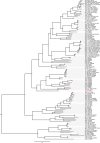Ecuador Paraiso Escondido Virus, a New Flavivirus Isolated from New World Sand Flies in Ecuador, Is the First Representative of a Novel Clade in the Genus Flavivirus
- PMID: 26355096
- PMCID: PMC4645344
- DOI: 10.1128/JVI.01543-15
Ecuador Paraiso Escondido Virus, a New Flavivirus Isolated from New World Sand Flies in Ecuador, Is the First Representative of a Novel Clade in the Genus Flavivirus
Abstract
A new flavivirus, Ecuador Paraiso Escondido virus (EPEV), named after the village where it was discovered, was isolated from sand flies (Psathyromyia abonnenci, formerly Lutzomyia abonnenci) that are unique to the New World. This represents the first sand fly-borne flavivirus identified in the New World. EPEV exhibited a typical flavivirus genome organization. Nevertheless, the maximum pairwise amino acid sequence identity with currently recognized flaviviruses was 52.8%. Phylogenetic analysis of the complete coding sequence showed that EPEV represents a distinct clade which diverged from a lineage that was ancestral to the nonvectored flaviviruses Entebbe bat virus, Yokose virus, and Sokoluk virus and also the Aedes-associated mosquito-borne flaviviruses, which include yellow fever virus, Sepik virus, Saboya virus, and others. EPEV replicated in C6/36 mosquito cells, yielding high infectious titers, but failed to reproduce either in vertebrate cell lines (Vero, BHK, SW13, and XTC cells) or in suckling mouse brains. This surprising result, which appears to eliminate an association with vertebrate hosts in the life cycle of EPEV, is discussed in the context of the evolutionary origins of EPEV in the New World.
Importance: The flaviviruses are rarely (if ever) vectored by sand fly species, at least in the Old World. We have identified the first representative of a sand fly-associated flavivirus, Ecuador Paraiso Escondido virus (EPEV), in the New World. EPEV constitutes a novel clade according to current knowledge of the flaviviruses. Phylogenetic analysis of the virus genome showed that EPEV roots the Aedes-associated mosquito-borne flaviviruses, including yellow fever virus. In light of this new discovery, the New World origin of EPEV is discussed together with that of the other flaviviruses.
Copyright © 2015 Alkan et al.
Figures



References
-
- Pletnev A, Gould E, Heinz FX, Meyers G, Thiel HJ, Bukh J, Stiasny K, Collett MS, Becher P, Simmonds P, Rice CM, Monath TP. 2011. Flaviviridae, p 1003–1020. In King AMQ, Adams MJ, Carstens EB, Lefkowitz EJ (ed), Virus taxonomy. Elsevier, Oxford, United Kingdom.
MeSH terms
LinkOut - more resources
Full Text Sources
Other Literature Sources
Molecular Biology Databases

